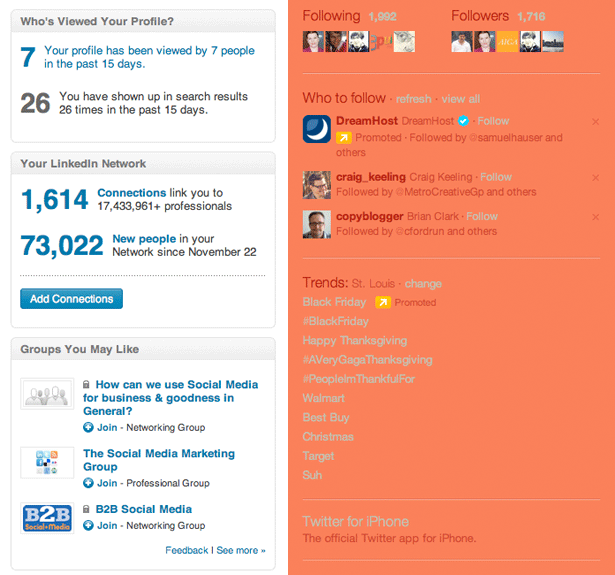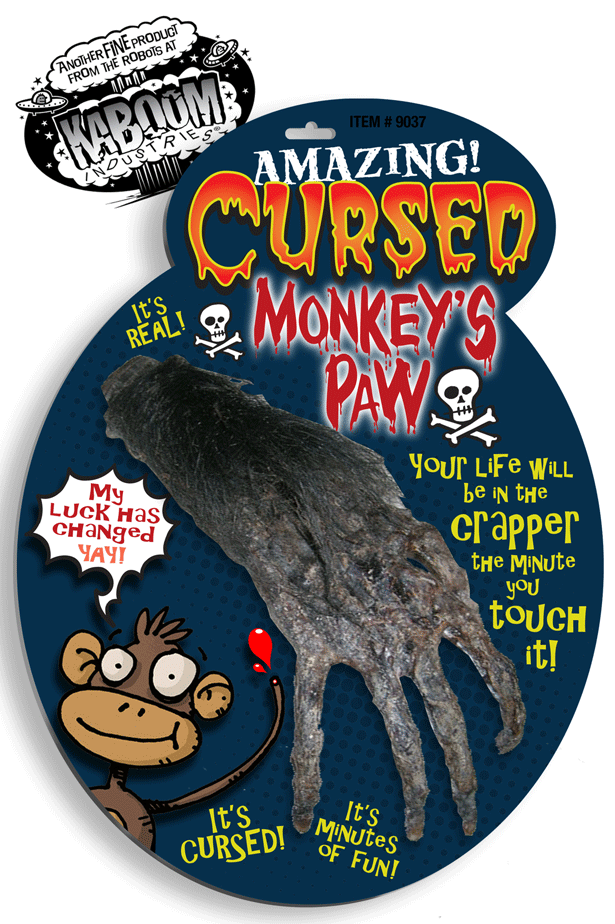 I’m amazed at companies, especially marketing firms, that stop their social media. It’s usually a blog that hasn’t been updated in a year or the proud display of fans numbering less than ten, eight of them being employees at that firm. What does that tell potential clients? It says that firm has no idea about social media. As someone who deals with social media on a daily basis, I see the value and I see the mistakes. It seems easy, in my mind, but I know it’s not or companies wouldn’t make so many mistakes.
Certainly social media has taken business by storm. People are still in a quandary about how it works, despite proven stats and ROI. Some companies do it on the cheap and some throw millions into it. It seems odd that so many people can’t see what social media is all about – being social!
When I hear someone say, “I don’t like Facebook,” I think, “enjoy the rest of the 20th century and I’ll catch up with you later…maybe!”
It is, of course, more serious than that. If you’re not keeping in touch with old friends and former coworkers, you are letting your network die and, as many articles keep pounding into our heads, your network is the most important way to get work. As with the occasional phone call to a close friend to see if they’re still alive, sharing some news and laughs and just showing them that you care, social media is the new phone call—it’s how we are social now. It’s important and cannot be ignored.
I’m amazed at companies, especially marketing firms, that stop their social media. It’s usually a blog that hasn’t been updated in a year or the proud display of fans numbering less than ten, eight of them being employees at that firm. What does that tell potential clients? It says that firm has no idea about social media. As someone who deals with social media on a daily basis, I see the value and I see the mistakes. It seems easy, in my mind, but I know it’s not or companies wouldn’t make so many mistakes.
Certainly social media has taken business by storm. People are still in a quandary about how it works, despite proven stats and ROI. Some companies do it on the cheap and some throw millions into it. It seems odd that so many people can’t see what social media is all about – being social!
When I hear someone say, “I don’t like Facebook,” I think, “enjoy the rest of the 20th century and I’ll catch up with you later…maybe!”
It is, of course, more serious than that. If you’re not keeping in touch with old friends and former coworkers, you are letting your network die and, as many articles keep pounding into our heads, your network is the most important way to get work. As with the occasional phone call to a close friend to see if they’re still alive, sharing some news and laughs and just showing them that you care, social media is the new phone call—it’s how we are social now. It’s important and cannot be ignored.
Your network
There are too many articles out there about the importance of having a strong network, so I won’t elaborate too much. Suffice it to say that if you aren’t keeping in touch with the people you know, you are losing valuable contacts. We all have friends that we forget to call every now and then. When we have a chance meeting with them in the street, it’s an awkward moment of lying about being “too busy” or “I was thinking about you the other day.” Admit that it happens to you, too. That relationship is weakened or broken either through the embarrassment of having been caught in not caring enough or using the age-old excuse. The importance of Facebook connections, at least in my case with old friends and former coworkers is that I can continue to tease them and show I care in just a few minutes a day. I’m at my computer 18 hours a day, so why not use it to reach out? LinkedIn, while more business oriented is another important network but it goes beyond people we know or have known. As with Twitter, with whom do you connect? Creatives tend to be drawn together in life and on social media. We follow other creatives, connect with them and spend an inordinate amount of time-sharing our work, dreams and disappointments. Misery does love company but how much time is spent on this commiseration as opposed to searching for solid business contacts? When it comes to business, other designers aren’t the number one source of work for us as freelancers or referrals. The dark side of relying too much on connections with other designers is that they can sabotage others. People can be petty and the current financial and competitive environment is fierce. Learn to trust your own efforts! While your trusted friends, whether designers or “normal” people, are great connections and should be treasured and nurtured, you need to seek out those who BUY your services. Both LinkedIn and Twitter have intuitive feedback that help you connect, join groups, hashtag to hot trends and see who is following you or viewing your profile. Use this information to connect with the right people!
Both LinkedIn and Twitter have intuitive feedback that help you connect, join groups, hashtag to hot trends and see who is following you or viewing your profile. Use this information to connect with the right people!
Blogging
We are in a Googled world of information flying left and right. With sites like Stumbleupon and Digg, just to name two, and aggregators by the dozens, your blog will cross someone’s path at some point, either via a shared link, Facebook “like,” or just showing up in a search for some odd term. The key is to bring that person BACK to your blog again and again. At my last full time job, people complained that I sent too many links every day. I would send out interesting product ideas or inspirational pieces to people in my department for the good of our company and business. Blogging wasn’t as popular as it is now (this was only seven or eight years ago, mind you) and I was receiving a weekly email blast from a design studio, which they called “The Hip-O-Meter.” It simply had three entries of interesting products or links, which weren’t even done by the studio. There was “Hip,” “Hipper” and “Hippest.” They followed it with a short blurb about something the studio had created as an ad for their services. Simple and brilliant. They touted that the e-newsletter, which was only type, went out to four thousand people. I was inspired but took it to the next level. Taking all of the daily links I would send out, I created an e-newsletter with an embedded animated gif header, designed separators for each entry and drew together a dozen or so links of unique ads, products and other interesting stuff that would provide inspiration for our company business. Each Monday morning, the “Innovation Lounge,” as I called it, would go out to the department email list. Within a couple of months, it was going company wide solely through requests from different departments. The power of viral blogging that was shared by workers at this twenty-five thousand-person company and distribution grew. Workers even shared it with people outside the company. When I was laid off from the company (that’s a whole other article in itself!), I branded my new freelance-self and started a similar blog, using Twitter, Stumbleupon, Yahoo and Google to drive traffic with links to the new entries, email blasts to former coworkers and other connections and created an opt-in list for new subscribers aside from those subscribing to the RSS feed. Thanks to the viral nature of the web, the blog garnered over seven hundred unique hits on days new content was published. The downside was it took a LOT of time and research. When my branding changed (yet another article… which is actually out there on someone else’s blog), I abandoned the blog but every now and then I check the stats and it still gets between fifty and two-hundred hits per day due to the tags and images. The key to this blog is that it was aimed at prospective clients. As with the “Hip-O-Meter,” it contained an ad for my services at the end of each entry. If I spotlighted vending machines, the ad focused on my studio’s ability to do work along that line and so on. The mistake many designers make with their blogs is they focus on design issues and techniques that only appeal to other designers. Other designers do not buy your services, so it’s a waste of time. Focus your efforts on business and not fame among peers. Blogging is a great way to reach prospects but very labor intensive. This is why many firms start to ignore their blogs – they don’t want to have an employee using their time to update the content or pay for someone to dedicate the time and effort. I have several clients that pay me to write blog posts for them. The big danger with a blog is having it show that it hasn’t been updated for months or over a year. It reflects badly on you and your company. Update it at least once a week, even if it’s just one little blurb. Ignore it and it is a blot on your company’s ability to keep up with marketing, which is not a good sign in our business.Direct mail
Yes, what’s old is new again! I traded my blogging in for something less time-intensive but a little more expensive – direct mail. I created a “wish list” of one hundred dream clients (and about 100 other people with whom I wanted to keep in touch) and send out a greeting card format card with examples of work and a funny message. At first I sent out one a month for the first six months. After that it was one every three months. Due to costs, it’s about twice to three times a year now but I hear back from people how they “loved” the card and either show it to other people or it’s made the prominent place of being tacked to their bulletin board. Being in plain sight is one of the best advertisements as it reminds clients about you and other people will see it and take a look. Referrals from these cards have grown my mailing list. Some figures on mailings are startling. The average person opens 14% - 28% of all email. 48% of all snail mail is opened but 98% of greeting cards are opened…and opened first! As with blogging and other social media, it’s important to balance time + effort + costs to equal a return on investment (ROI). Fun images showing your work will get posted on people's bulletin boards, so think of using interesting designs for direct mail pieces, like the ones below.


Face-to-face
Never forget the power of actually meeting people. This gets back to “your network” and you need to spend time building and replenishing that network. It’s hard for creatives to properly network. First: we have to talk to people who are not other creatives. Second: we are strange, which adds to our creativity. If I had to make a list for creatives to follow in social networking situations, I would have the following important rules:- Listen more, talk less. The more you talk, the greater the chance you’ll say something strange and upset the people you want to impress.
- Let your work do your talking for you! Why hand out a business card when you can hand our a set of images and let people faun over it? Don’t print up letter-sized promotional pieces as people like things they can just put in their pockets. Why not think “flash cards” and create a small set of images that are business card-sized to hand out?
- Ask about the person you are meeting. People love to talk about themselves. Once they have finished talking about their business, one of the best answers I have ever heard in response to listening to someone who has just finished pontificating about what they do is, “I help businesses like yours!”
- Don’t tell them too much. Give them the snappy answer mentioned above and then hand them your samples. Tell them you provide marketing services for business. Either they will nod and walk away or they will tell you about something they need. BINGO!
- Don’t dress TOO creatively. A nice weird pair of shoes is a focal point. Purple Mohawks, studded leather jackets with tartan pants and jackboots are a bit much for the business crowd. Remove the piercings, hide the tattoos and look just like the people you are trying to reach. You aren’t “selling out,” you’re selling!
In conclusion…
All of the avenues mentioned in this article are dovetailed to work together. One is not better than the others and some just may not be necessary for what you want to accomplish. Any small business needs to advertise, market, brand and reach out to prospective clients. Target your clients and go after them. The idea is to use what works best for your needs, keep at it and make everything count towards gaining clients and business. When you don’t have actual paying work, use the time to market yourself but use it wisely! What social media channels have you found effective for your business? Which ones are not effective? What do you think of the media outlets mentioned in this article?Speider Schneider
Speider Schneider is a former member of The Usual Gang of Idiots at MAD Magazine and has designed products for Disney/Pixar, Warner Bros., Harley-Davidson, ESPN, Mattel, DC and Marvel Comics, Cartoon Network and Nickelodeon among other notable companies. Speider is a former member of the board for the Graphic Artists Guild, co-chair of the GAG Professional Practices Committee and a former board member of the Society of Illustrators. Follow him on Twitter @speider or add him on Google+
Read Next
3 Essential Design Trends, May 2024
Integrated navigation elements, interactive typography, and digital overprints are three website design trends making…
How to Write World-Beating Web Content
Writing for the web is different from all other formats. We typically do not read to any real depth on the web; we…
By Louise North
20 Best New Websites, April 2024
Welcome to our sites of the month for April. With some websites, the details make all the difference, while in others,…
Exciting New Tools for Designers, April 2024
Welcome to our April tools collection. There are no practical jokes here, just practical gadgets, services, and apps to…
How Web Designers Can Stay Relevant in the Age of AI
The digital landscape is evolving rapidly. With the advent of AI, every sector is witnessing a revolution, including…
By Louise North
14 Top UX Tools for Designers in 2024
User Experience (UX) is one of the most important fields of design, so it should come as no surprise that there are a…
By Simon Sterne
What Negative Effects Does a Bad Website Design Have On My Business?
Consumer expectations for a responsive, immersive, and visually appealing website experience have never been higher. In…
10+ Best Resources & Tools for Web Designers (2024 update)
Is searching for the best web design tools to suit your needs akin to having a recurring bad dream? Does each…
By WDD Staff
3 Essential Design Trends, April 2024
Ready to jump into some amazing new design ideas for Spring? Our roundup has everything from UX to color trends…
How to Plan Your First Successful Website
Planning a new website can be exciting and — if you’re anything like me — a little daunting. Whether you’re an…
By Simon Sterne
15 Best New Fonts, March 2024
Welcome to March’s edition of our roundup of the best new fonts for designers. This month’s compilation includes…
By Ben Moss
LimeWire Developer APIs Herald a New Era of AI Integration
Generative AI is a fascinating technology. Far from the design killer some people feared, it is an empowering and…
By WDD Staff

















